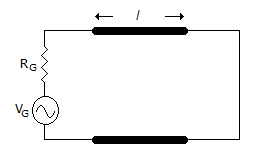Discussion
Home ‣ Electronics and Communication Engineering ‣ Microwave Communication See What Others Are Saying!
- Question
In the given figure a short circuited transmission line resonator If n = 1, 2, 3...

Options- A. For series reasonance ?l = np and for parallel resonance

- B. For series resonance
 and for parallel resonance ?l = np
and for parallel resonance ?l = np - C. ?l = np for both series and parallel resonance
- D.
 for both series and parallel resonance
for both series and parallel resonance - Correct Answer
- For series reasonance ?l = np and for parallel resonance

- 1. A radar has a maximum range of 120 km. The maximum allowable pulse repetition frequency for unambiguous reception is
Options- A. 1250
- B. 330
- C. 2500
- D. 8330 Discuss
- 2. An unmodulated voltage 10 V effective is applied to a dioxide detector in which load resistance is 4 x 10-5 ohms. A micrometer shows that the rectified DC current in this resistance is 30 A. The input resistance of the detector is
Options- A. 114 kW
- B. 336 kW
- C. 384 kW
- D. 455 kW Discuss
- 3. For a BJT a = 0.98, then ? =
Options- A. 0.02
- B. 0.5
- C. 4.9
- D. 48 Discuss
- 4. If the temperature of an extrinsic semiconductor is increased so that the intrinsic carrier concentration is doubled, then
Options- A. the majority carrier density is doubled
- B. the minority carrier density is doubled
- C. the minority carrier density becomes 4 times the original value
- D. both the majority and minority carrier densities double Discuss
- 5. A cycloconverter is
Options- A. ac-dc converter
- B. dc-ac converter
- C. dc-dc converter
- D. ac-ac converter Discuss
- 6. Consider the following DO statement in Fortran 77
DO 52 N = 1, 10, 3
The number of DO loop executions in the above statement is
Options- A. 1
- B. 10
- C. 3
- D. 4 Discuss
- 7. In a single phase semiconverter feeding a highly inductive load, the load current is
Options- A. sinusoidal
- B. nearly constant
- C. absolutely constant
- D. rectangular Discuss
- 8. If ton and toff are the turn on and turn off times of a thyristor, then
Options- A. ton and toff are almost equal
- B. ton >> toff
- C. toff >> ton
- D. ton is about twice toff Discuss
- 9. Which inverter circuit uses coupled inductors?
Options- A. Modified McMurray full bridge inverter
- B. McMurray Bedford half bridge inverter
- C. Modified McMurray Bedford half bridge inverter
- D. Both (b) and (c) Discuss
- 10. If there are no permanent dipoles in a dielectric material, the dielectric constant is independent of temperature.
Options- A. True
- B. False Discuss
More questions
Correct Answer: 1250
Correct Answer: 336 kW
Correct Answer: 48
Explanation:

Correct Answer: both the majority and minority carrier densities double
Explanation:
As the intrinsic carrier concentration is doubled, the concentration of both electrons and holes is doubled.
Correct Answer: ac-ac converter
Explanation:
It changes ac at frequency f into ac at a frequency different from f.
Correct Answer: 4
Explanation:
Do statement is executed when N = 1, 4, 7, 10, i.e., a total of 4 times.
Correct Answer: nearly constant
Correct Answer: toff >> ton
Explanation:
Turn on time is less than 3 ?s while turn off time is between 10-300 ?s.
Correct Answer: Both (b) and (c)
Correct Answer: True
Comments
There are no comments.More in Electronics and Communication Engineering:
Programming
Copyright ©CuriousTab. All rights reserved.
